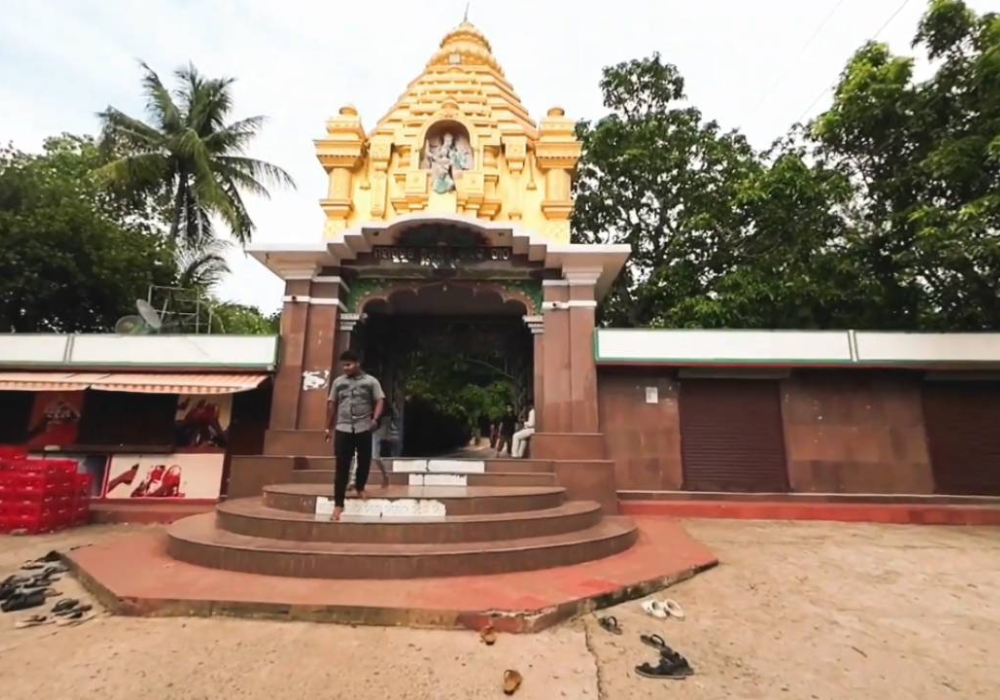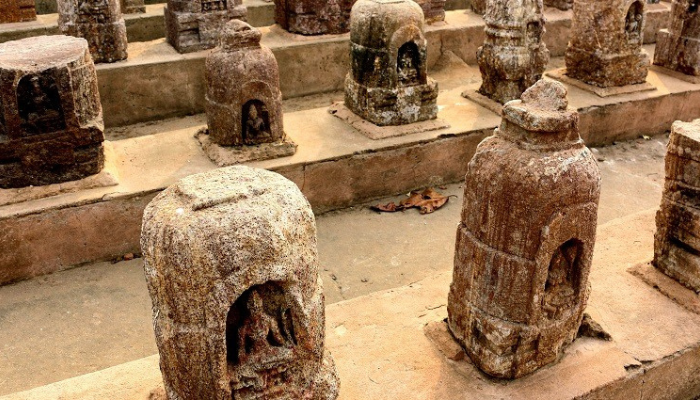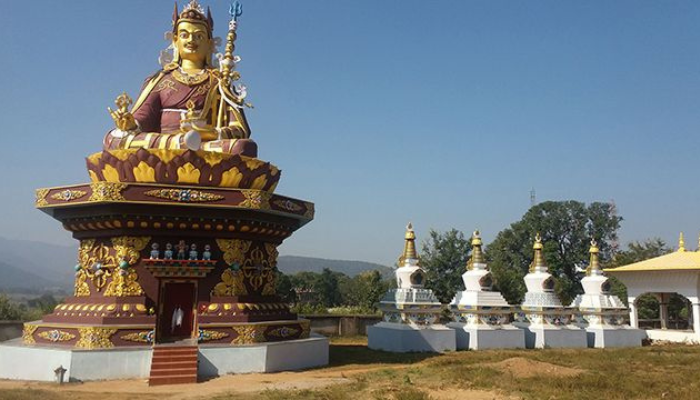
The Olasuni Temple is in Odisha. It sits amidst serene landscapes. This temple shows deep spiritual heritage. It also highlights historical depth. This revered pilgrimage site is very important. It links to the great saint Arakhita Das. It draws countless devotees. History enthusiasts also visit. People often call it the Mahasamadhi temple. This refers to Santha Arakhita Das. It offers a unique blend of traditions. Natural beauty is also present. Visitors seek blessings from the goddess Olasuni. They immerse themselves in the tranquil aura. This happens at Olasuni Hill in Jajpur. This guide explores this sacred destination. It covers its rich legends. Rituals and spiritual legacy are also discussed.
The Sacred Abode: Location and Landscape of Olasuni Temple
The Olasuni Temple is on Olasuni Hill. Locals call it Olasuni Pahada. It is in the Jajpur district of Odisha. The tranquil Gobari River is nearby. This river is also known as Gomati. It is adjacent to National Highway 53. This highway leads towards Paradeep. Its easy accessibility makes it popular. Pilgrims and tourists visit often. This sacred hill is at the intersection. It joins the Cuttack and Jajpur districts. This creates a picturesque setting. It captivates every visitor.
A Confluence of Nature and Spirituality
The natural beauty around the Olasuni Temple Jajpur is captivating. Lush green forests adorn the hill. Vibrant flora is also present. This offers a refreshing escape. It provides relief from urban life. Cool breezes and a tranquil environment exist. These make it ideal for meditation. It is also good for introspection. Furthermore, the temple offers panoramic views. These views include rolling hills. Verdant plains are also visible. This enhances the spiritual experience. It benefits those who trek to the shrine.
Proximity to Buddhist Heritage Sites
The Olasuni Temple area has a rich history. It is very close to famous Buddhist sites. These are Lalitgiri, Ratnagiri, and Udayagiri. They form the Buddhist Diamond Triangle. This proximity highlights the region’s ancient past. It was a significant center for various spiritual traditions. This includes Buddhism. It later became Hinduized. This blend of narratives is unique. Ancient Buddhist practices are here. Hindu deities and saints are also venerated. This makes Olasuni a truly unique cultural landscape. It offers an enriching experience. This is for anyone interested in Odisha’s religious history.
The Revered Saint: Santha Arakhita Das and His Legacy
The profound legacy of Santha Arakhita Das is central. It is at the heart of the Olasuni Temple’s spiritual significance. He is the main figure here. Much of the site’s reverence revolves around him. His life story involves renunciation. It also includes deep spiritual practice. He propagated universal humanism.
From Royalty to Renunciation
He was born as Balabhadra Deb. He was the elder son of Padamalav Dev. This king was from the Ganga dynasty. Their estate was Badakhemundi. It was in Ganjam district. Santha Arakhita Das renounced his princely life. He did this at a young age. Reports say he was 14 to 18 years old. His quest was for divine truth. It led him to abandon worldly pleasures. He embarked on a spiritual journey. He traveled widely across Kalinga. This is modern-day Odisha. He sought a perfect place for meditation. After much searching, he chose Olasuni Hill. It became his ‘sadhana pitha.’
The Path of ‘Omkara Yoga’ and ‘Abadhuta Bada’
Santha Arakhita Das meditated deeply. He used a cave on Olasuni Hill. It is called Sidha Gumpha or Olasuni Gumpha. Here, he practiced ‘Omkara Yoga.’ He attained deep spiritual realization. He became a ‘Brahma Avadhuta.’ His teachings focused on “Sunya Brahma.” This means God is formless. God is also beyond attributes. There should be no caste barriers. This applies to worship of the divine. This philosophy is ‘Abadhuta Bada.’ It promoted universal humanism. Fraternity and unity were also key. It transcended traditional societal divisions. Thus, the Olasuni Temple symbolizes inclusivity. It represents spiritual equality.
Literary Contributions
Santha Arakhita Das made literary contributions. He did this during his time at Olasuni. He authored several spiritual texts. The most notable is the “Mahimandala Geeta.” It is a palm leaf manuscript. It consists of 93 chapters. Other works include “Bhakti Tika.” “Saptanga Abadhuta Samhita” is another. “Tatwa Sara Geeta” is also important. These writings still guide followers. They offer deep insights into his philosophy.
The Mahasamadhi and the Mahasamadhi Temple
Santha Arakhita Das attained Mahaparinirvana. This is also called Samadhi. It happened in the cave. The day was Magha Krushna Ekadasi. This is an auspicious Hindu day. Some sources say this was around 1835 AD. Others suggest 1837 AD. The Mahasamadhi temple was built to honor him. Its construction was between 1835 and 1850 AD. This temple uses dressed Khondolite stone. The stone came from the hillock itself. It enshrines his Mahaprayana Gadi. This is not a traditional temple. It is a sacred Samadhi Pitha. It is a place of deep reverence for the saint. Thus, the Mahasamadhi temple is a focal point. Devotees seek his blessings here. They also seek spiritual guidance.
The Divine Presence: Goddess Olasuni
Santha Arakhita Das is central to the site. However, the goddess Olasuni is also important. She holds a significant place. This is true in the hearts of devotees. Her temple is at the foot of Olasuni Hill. It is near the Gobari River. Her presence adds spiritual depth. This enriches the sacred landscape.
Ancient Origins and Transformation
The history of the goddess Olasuni is ancient. It intertwines with the region’s past. The site included the Olasuni Gumpha (cave). It was originally linked to a Buddhist goddess. This was Prajnaparamita. Buddhist monks worshipped her. She was a four-handed goddess. This occurred within the cave. It continued until the 11th or 12th century AD. Buddhism declined in the area. The goddess was then Hinduized. She became known as Olasuni Devi. This happened around the 12th or 13th century AD. Legend says the goddess descended. This happened after Santha Arakhita Das’s appeal. She moved from the cave. She went to the hill’s isolated foot. This was by the Gobari river. This occurred in the early 18th century AD.
Folklore and Local Beliefs
Another local folklore exists. It suggests the hill and temple are named after a girl. Her name was Olasuni. She was a brave tribal girl. She reportedly sacrificed her life. This was to protect her people from invaders. Her courage and devotion made her revered. This narrative highlights diverse influences. Cultural and historical factors shaped the temple’s identity. Consequently, the temple stands as a testament. It shows ancient spiritual transitions. It also reflects local heroic tales.
The Temple’s Architecture and Ambiance
The Olasuni Temple is dedicated to the goddess Olasuni. It is built in traditional Odia style. Its design shows the deep faith. It reflects the fervor of local people. The temple compound is well-maintained. It offers a calm and serene ambiance. This enhances the spiritual feeling for visitors. Daily prayers and rituals occur. During major festivals, it becomes busy. The Olasuni Mela is an example. Devotees share stories of miracles. They also recount divine encounters. This strengthens the temple’s reputation. It is known as a powerful spiritual center.
The Vibrant Olasuni Mela: A Celebration of Faith and Culture
The annual Olasuni Mela is a key event. It is also called Gumpha Yatra. Or it is Gumpha Ekadasi. It is the most significant event. This is true in Olasuni’s calendar. This vibrant fair attracts thousands. Devotees come from Odisha and nearby states. It transforms the hill. It becomes a lively center. Devotion and festivity are evident.
Commemorating a Saint’s Mahasamadhi
The Olasuni Mela primarily commemorates a day. It is the Mahasamadhi Day of Santha Arakhita Das. It starts on Magha Krushna Ekadasi. This auspicious day marks the saint’s passing. The fair usually lasts a week. Sometimes it spans nine days. This depends on the year. This long duration allows many visitors. They participate in spiritual events. Cultural activities are also held.
Rituals and Offerings
Devotees gather during the Olasuni Mela. They offer prayers. They also partake in rituals. A unique offering is made. It is at the Mahasamadhi temple. This is for Santha Arakhita Das. Offerings include ‘Podapitha’. This is a baked cake. It is made from rice and cereals. ‘Sukhua’ (dried fish) is also offered. Even ‘Somarasa’ (wine) is given as ‘samarpana bhoga’. Another significant offering is ‘Kanjipani’. This is a soup. It is made from rice gruel. People believe Kanjipani has medicinal properties. Some claim it cures various ailments. Thousands partake in the ‘prasada seva’. This means partaking of offerings. They sit together without hesitation. This is irrespective of caste or creed. This practice reflects the saint’s teachings. It embodies universal humanism. It also shows the eradication of untouchability.
A Hub of Culture and Commerce
The Olasuni Mela is spiritually significant. It also serves as a platform. This is for cultural exchange. It is also for commerce. The fair features lively processions. Traditional music and dance are performed. Local artisans set up stalls. They showcase and sell handicrafts. Souvenirs are also available. Delicious Odia sweets are sold. The mela is famous for stone craft. This includes grinders and ‘chakis’. Idols of deities are also sold. Skilled artisans bring these items. They come from nearby villages. Sukhuapada and Lalitgiri are examples. The demand for traditional grinders has lessened. This is due to modern alternatives. However, the artistry remains a highlight. The fair also attracts brass craftspersons. This enriches its diversity. This blend makes the mela immersive. It combines devotion, culture, and economy.
Historical Evolution of Olasuni: A Tapestry of Beliefs

The history of Olasuni Hill is fascinating. It tells a story of changing religions. It also shows the assimilation of traditions. The site has evolved over centuries. This reflects the dynamic nature of faith in Odisha.
From Buddhist Site to Hindu Shrine
Archaeological evidence suggests this. Olasuni Hill was a Buddhist site. This dates back to the 1st century BC or AD. Buddhist monks and nuns used rock-cut caves. Examples include Sidha Gumpha (Olasuni Gumpha). Others are Khola Gumpha, Ananta Gumpha, and Paduka Gumpha (Muni Gumpha). These were for meditation and yoga. The worship of Prajnaparamita continued. This was the Buddhist goddess. It happened within these caves. It lasted until the 11th or 12th century AD. However, Buddhism declined. The site gradually transformed.
The Rise of Hindu Influence
Around the 12th or 13th century AD, the site became Hinduized. The former Buddhist goddess Prajnaparamita was re-identified. She was then worshipped as the goddess Olasuni. This transition shows Odisha’s syncretic practices. Older traditions were absorbed. They were reinterpreted in a new framework. The hill then became “Olasuni Pitha.”
The ‘Omkara Abadhuta Pitha’ Era
The late 18th century AD saw another change. The site became the “Omkara Abadhuta Pitha.” This period aligns with an event. It is the arrival of Santha Arakhita Das. His spiritual awakening occurred then. His teachings shaped Olasuni’s identity. These included “Omkara Yoga” and “Abadhuta Bada.” This made it a center for his philosophy. Therefore, the Mahasamadhi temple was built. It dates to the 19th century. It became the spiritual heart of this site.
The history of Olasuni Temple Jajpur is evolving. It went from a Buddhist ground and became a Hindu pilgrimage site. It centers on a saint’s Samadhi. This shows its enduring significance. It also highlights its adaptability. It beautifully showcases Odisha’s religious history.
Exploring Olasuni: Beyond the Temples
The Olasuni Temple is a main attraction. The Mahasamadhi temple is too. However, the surrounding area offers more. Visitors have much to explore. This ranges from ancient caves. It includes serene nature camps. Olasuni provides a holistic experience. This is for pilgrims and tourists.
The Mysterious Olasuni Caves
Olasuni Hill has several caves. Each has its own history. Each has a spiritual aura. The most notable is the Sidha Gumpha. It is also called the Olasuni Gumpha. Santha Arakhita Das meditated here. This cave has a narrow entrance. It leads to a wider interior. It is believed to be a place of deep meditation. Visitors often feel peace. They feel tranquility within its cool walls. Other caves include:
Khola Gumpha
Ananta Gumpha
Paduka Gumpha (Muni Gumpha)
These contribute to the site’s mystique. These caves highlight the region’s history. It was a long-standing spiritual retreat.
Olasuni Nature Camp: A Retreat Amidst Nature
The Olasuni Nature Camp offers comfort. It is for those extending their stay. It allows immersion in nature. The camp has well-furnished cottages. They have attached facilities. It sits on the slope of Olasuni Hill and an ideal base for nature lovers. It is good for trekking. Nature photography is also popular. Guests can simply enjoy the serene environment. The camp has a common facility center. It serves both vegetarian and non-vegetarian food. This ensures a comfortable stay. This blend makes Olasuni attractive. It combines pilgrimage and eco-tourism.
Nearby Attractions: The Buddhist Triangle
As noted earlier, the Olasuni Temple Jajpur is close to famous sites. These are Buddhist heritage sites. They are Lalitgiri, Ratnagiri, and Udayagiri. They form the Buddhist Diamond Triangle. Lalitgiri is known for ancient stupas. It has monasteries and archaeological remains. It is just 3 km west of Olasuni Hill. Visiting these sites offers a chance. It is to delve deeper into Odisha’s Buddhist past. It helps understand the broader history. Combining Olasuni with these sites is good. It provides a comprehensive experience. This includes culture and history.
Planning Your Visit to Olasuni Temple

Visiting the Olasuni Temple is a unique experience. It offers spiritual and cultural insights. Planning your trip well is important. It ensures a comfortable and enriching journey. This is to this sacred site.
Best Time to Visit
The ideal time to visit is during cooler months. This is from October to March. The weather is pleasant then. It is good for exploring the hill. It is also good for caves and activities. The annual Olasuni Mela is a highlight. It is usually in January or February (Magha month) and draws large crowds. It offers a vibrant cultural experience. The monsoon season is June to September. Heavy rains might cause disruptions.
How to Reach Olasuni Temple
The Olasuni Temple Jajpur is well-connected. It is accessible by various transport modes.
By Road
The temple is conveniently located. It is near National Highway 53. This was formerly NH-5A. It is about 60 km from Cuttack. This is via Chandikhol Road. It is about 44 km from Jajpur town. The nearest bus stop is Chandikhol. This is around 22 km away. Taxis and local transport are available. They come from major towns in Odisha. They reach the temple easily.
By Rail
The nearest railway station is Jajpur Keonjhar Road. It is about 60 km from the Olasuni Temple. Cuttack railway station is also a major railhead. It is in the vicinity. From these stations, visitors can hire taxis. They can also use public transport to reach Olasuni.
By Air
The nearest airport is Biju Patnaik International Airport (Bhubaneswar). It is about 80 km from the Olasuni Nature Camp. From the airport, visitors can hire a taxi. They can also take a bus. This ensures easy access. Both domestic and international travelers can reach the site.
Accommodation Options
The Olasuni Nature Camp offers cottages. They are well-furnished. These are on the hill. They are for visitors planning an overnight stay. Various hotels are also available. Guesthouses are in nearby towns. These include Chandikhol, Cuttack, and Jajpur. They cater to different budgets. Booking accommodation in advance is recommended. This is especially true during the Olasuni Mela. This is due to the large influx of devotees and tourists.
The Enduring Appeal of Olasuni Temple
The Olasuni Temple in Odisha is unique. It holds a special place. People visit for religious reasons. They also come for its history. Its natural beauty draws them. The site represents a living tradition. Ancient practices blend with modern devotion.
A Beacon of Unity and Inclusivity
Santha Arakhita Das’s teachings still resonate. His “Abadhuta Bada” philosophy is key. It advocates a casteless society. It promotes universal spiritual truth. The communal sharing of ‘prasada’ shows this. This happens during the Olasuni Mela. People from all backgrounds sit together. This exemplifies unity and fraternity. This inclusive spirit makes the Olasuni Temple a powerful symbol. It represents harmony and shared faith.
Spiritual Healing and Serenity
Many devotees visit Olasuni. They seek spiritual solace. They also seek healing. Belief in ‘Kanjipani’ is strong. It is thought to have medicinal properties. The hill’s serene atmosphere helps. The caves contribute too. Visitors feel rejuvenated. The tranquil surroundings are ideal. They promote introspection. They foster a deeper spiritual experience.
Cultural Preservation and Tourism
The Olasuni Mela also plays a role. It preserves rich cultural heritage. It also promotes it. Traditional arts and crafts are displayed. Cultural performances occur. This ensures traditions are passed down. They go through generations. Furthermore, the nature camp helps. The Olasuni Nature Camp is developed. Improved accessibility boosts tourism. More people experience the site’s charm. It is not just for pilgrimage. It is a center of cultural vibrancy and also offers natural splendor.
Frequently Asked Questions (FAQs) about Olasuni Temple
To help you plan your visit, here are some questions. They are frequently asked. They provide more information. This is about the remarkable Olasuni Temple.
What is the main significance of Olasuni Temple?
The Olasuni Temple is highly significant. It has spiritual and historical importance and primarily known as the sacred abode. It is also the Mahasamadhi temple of Santha Arakhita Das. He was a revered saint and preached universal humanism. He also taught ‘Omkara Yoga’. Additionally, it has a temple. This is dedicated to the goddess Olasuni. It also hosts the famous Olasuni Mela.
Where exactly is Olasuni Temple located?
The Olasuni Temple is on Olasuni Hill (Olasuni Pahada). It is in the Jajpur district of Odisha, India, and lies near the Gobari River. It is also near the National Highway 53 and borders the Cuttack district.
Who was Santha Arakhita Das?
Santha Arakhita Das was a prince. His name was Balabhadra Deb. He was from the Ganga dynasty and gave up his royal life. This was to pursue spiritual enlightenment. The place where he meditated was Olasuni Cave. He propagated “Sunya Brahma”and also taught “Abadhuta Bada”. He authored spiritual texts. “Mahimandala Geeta” is notable. His Mahasamadhi temple is a central point of worship.
What is the Olasuni Mela?
The Olasuni Mela is an annual fair. It is also called Gumpha Yatra or Gumpha Ekadasi. It is celebrated at Olasuni Hill and commemorates the Mahasamadhi of Santha Arakhita Das and typically occurs from Magha Krushna Ekadasi and lasts until Vasant Panchami. The mela is a vibrant event. It is cultural and religious. It features rituals and programs. A commercial fair is also held.
What are the special offerings (Prasad) at Olasuni Temple?
Unique offerings are made at Olasuni. These include ‘Podapitha’. This is a baked cake. ‘Sukhua’ (dry fish) is offered. ‘Somarasa’ (wine) is also given. ‘Kanjipani’, a rice gruel soup, is popular. It is believed to have medicinal properties. These offerings are part of the ‘Abadhuta Bada’ tradition.
Are there accommodations available at Olasuni?
Yes, accommodations are available. The Olasuni Nature Camp offers cottages. They are well-furnished. They are on Olasuni Hill. Various hotels are also nearby. Guesthouses are in towns like Chandikhol. Cuttack and Jajpur also have options. Booking in advance is wise. This is especially during peak festival times.
What other attractions are near Olasuni Temple?
The Olasuni Temple Jajpur is close to famous sites. These are Buddhist sites. They are Lalitgiri, Ratnagiri, and Udayagiri. They form the Buddhist Diamond Triangle. Lalitgiri has ancient stupas and monasteries. It is just 3 km away. Visitors can also explore caves. These are on Olasuni Hill itself.
Is Olasuni Temple suitable for a family visit?
Yes, the Olasuni Temple is family-friendly. Its spiritual atmosphere is appealing and historical significance is too. Its natural beauty offers something for all. The Olasuni Nature Camp provides family accommodation. The fair offers entertainment. It provides cultural experiences for all ages.
Conclusion: The Enduring Charm of Olasuni Temple
The Olasuni Temple is in Jajpur, Odisha. It is more than a religious site. It is a journey into devotion and explores historical evolution and showcases natural splendor. The revered Mahasamadhi temple is here. It is for Santha Arakhita Das. The ancient cave where he meditated is also here. The sacred shrine of the goddess Olasuni is present. Every aspect tells a story. The vibrant Olasuni Mela enriches the experience. It shows a blend of faith. It also displays culture and community spirit. You might be a devout pilgrim. You might seek spiritual solace. Or a history enthusiast. You might explore ancient traditions. Or a nature lover. You might look for tranquility. Olasuni Temple Jajpur offers an unforgettable experience. Its appeal lies in its ability to inspire. It also heals and unites. This makes it a cherished gem. It is in Odisha’s cultural tapestry.

Binu Lamba
Binu Lamba is a 29-year-old editor and fact-checker with 7 years of experience in travel content. He verifies all location details, hotel recommendations, and travel tips to ensure our guides are accurate, updated, and helpful for readers planning real trips.

AI Assistant
Our AI writing assistant supports the creation of travel content under strict human supervision. All AI-generated posts are thoroughly reviewed, fact-checked, and updated by our team to maintain trust and accuracy in our travel recommendations.

“Shopping Places in Mumbai – Best Markets & Street Shopping Spots”
Welcome to the ultimate guide to the best shopping places in Mumbai, a city that never sleeps and always shops. Mumbai offers a retail experience

“Best Cafe in Chennai – Top 5 Spots for Coffee Lovers”
Chennai’s vibrant culture extends to its thriving coffee scene. A new wave of cafes has emerged beyond traditional filter coffee. These spots offer artisanal brews

Best Way to Reach Udaipur: A Complete Travel Guide
If you’re planning a trip to the beautiful city of Udaipur, knowing how to reach Udaipur is essential for a smooth journey. This city is








